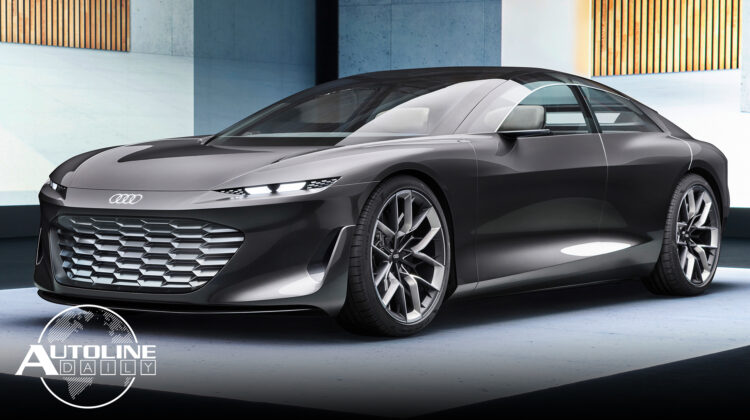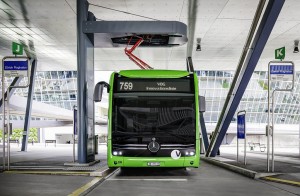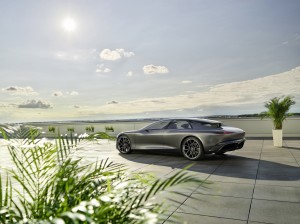

Follow us on social media:
Runtime: 9:52
0:08 Chip Shortage Forces More Production Cuts
1:02 German Automakers Face Lawsuit Over Emissions
1:35 BMW Commits to CO2 Reduction
2:06 CATL Puts Tesla in Its Crosshairs
3:09 Genesis Reveals Electrification Plans
4:03 Mercedes Tests New Method to Charge Electric Buses
4:48 Audi Unveils Sleek grandsphere concept
6:32 How Nissan Improved the Ride of The New Frontier
Visit our sponsors to thank them for their support of Autoline Daily: Bridgestone, Intrepid Control Systems, Magna and Schaeffler.
This is Autoline Daily, the show dedicated to enthusiasts of the global automotive industry.
CHIP SHORTAGE FORCES MORE PRODUCTION CUTS
When the chip shortage hit the auto industry at the beginning of the year, General Motors thought that things would be back to normal by the end of the summer. Well, we’re close to the end of summer, and the chip shortage is only getting worse. Next week GM is going to close almost all of its plants in North America. Automakers all over the world are cutting back on production. Bloomberg reports that Tesla had to stop production in China for 4 days. Ford is cutting out shifts in plants that make the F-150. And it says that tight inventory is changing how customers buy trucks. A year ago, only 6% of F-150 buyers ordered their trucks rather than buy what was on the dealer’s lot. Today 30% are ordering their trucks. So instead of trucks sitting on lots waiting for customers, we’ve got customers waiting for trucks.
GERMAN AUTOMAKERS FACE LAWSUIT OVER EMISSIONS
Greenpeace and an environmental NGO in Germany are threatening to sue BMW, Volkswagen and Mercedes if they don’t accelerate plans to stop producing cars with internal combustion engines. The EU wants to ban ICE sales by 2035 but the environmentalists want that to happen by 2030 to meet the Paris climate agreement goals and German climate law. They set a deadline of a couple of weeks for the automakers to respond to their demands.
BMW COMMITS TO CO2 REDUCTION
BMW must be taking all this to heart because hot on the heels of those threats, it released a statement committing to a 50% reduction in its CO2 emissions per vehicle by 2030 from 2019 levels. It’s also pledging to cut CO2 emissions over the entire life cycle of a vehicle by at least 40%. But we’re pretty sure that BMW is dead set against dropping all IC engines by 2030.
CATL PUTS TESLA IN ITS CROSSHAIRS
Looks like Chinese battery maker CATL just put Tesla in its crosshairs. CATL is partnering with a Chinese solar company called Jinko Solar to create solar-plus-storage products and an energy storage business. It will offer a package of a solar system with battery storage, and that goes right to the heart of Tesla’s Powerwall business.
GENESIS REVEALS ELECTRIFICATION PLANS
Genesis revealed the design of the new all electric GV60 and it dribbled out some interesting details. We showed you the vehicle a few weeks back, a sporty-looking 4-door fastback crossover. Genesis also showed some more details of its X concept car, including the fact it does not have a B-pillar, and and that it will offer swivel seats for easier ingress and egress. Genesis says by 2025, all the new cars it comes out with will be BEVs, but it also says that fuel cell EVs represent the best solution, though it did not announce when it might make them. What it did say is that by 2030 its entire lineup will be electric. It will have 8 new products in its lineup by 2030 and it plans to sell 400,000 vehicles a year.
MERCEDES TESTS NEW METHOD TO CHARGE ELECTRIC BUSES
Mercedes is testing a new way for it to charge its electric bus, the eCitaro. You may have seen this before, but it’s called a charging rail and you can kind of think of it like a reverse pantograph. Rather than a unit extending from the top of the bus to the charging lines, the equipment comes down from the charging station to the top of the bus. It’s able to charge the battery with 300 kW of output, which is double the rate that it’s capable of doing with a cable. So, rather than a bunch of wires all over the place, there’s only one central charging location. Mercedes says the bus will be able to operate up to 22 hours and cover 370 kilometers or about 230 miles a day.
AUDI UNVEILS SLEEK GRANDSPHERE CONCEPT
Speaking of electrics, but looking into the future, Audi showed off the grandsphere concept. At 5.35 meters or over 17.5 feet long, it’s a rather big vehicle. Audi uses that space to create the ultimate lounging area for passengers. And while it can be driven, the grandsphere is meant to be operated in autonomous mode. When the Level 4 system is activated, the steering wheel, pedals and front displays all disappear into the dash. That allows passengers to interact with each other or withdraw into their own little space to get some work done. This may seem like a far-off dream, but Audi says both technologies and design elements from the grandsphere will show up in the next few years. What do you think will make it?
HOW NISSAN IMPROVED THE RIDE OF THE NEW FRONTIER
We learned a lot about the new Nissan Frontier pickup truck on Autoline After Hours yesterday. One of the outstanding features of the pickup is how well it rides on the road despite being a body-on-frame vehicle. We asked Malaina Vasko, the vehicle performance manager at Nissan’s Tech Center, what they did to get such a good ride. Here’s what she had to say.
“One of the things that my team does is we set the subjective targets for the performance teams to try and meet. And we set very aggressive targets. There was a lot of doubt as to whether that was technically feasible. One of the things we really challenged our chassis team and our NVH team to do was to get as close to the (Honda) Ridgeline as possible for ride comfort. We wanted it to ride as comfortable as a unit-body vehicle. And you can imagine, the engineering world came back to us and said, ‘Oh no no, it’s a body-on-frame vehicle, that’s not possible.’ And our kind of stance was, ‘Try. Tell us what you need: time, cost, resources–what do you need to do that?’ And our chassis dynamics team and our chassis design team delivered it. I remember the first time I drove it when we first got vehicles last March of 2020. It wasn’t tuned or anything but we were blown away. We were blown away by the ride isolation–that you don’t feel every crack in the road. It isn’t like a typical body-on-frame vehicle. And I remember going to the chassis dynamics team and saying, ‘You’re going to go tune now and you’re going to hit this out of the park. You’re going to do exactly what we wanted you to do.’ And it was really refreshing to hear that feedback during the media drive that so many people recognized that we essentially delivered a unit-body ride comfort level in this body-on-frame truck. So it took a lot of tuning and our chassis team did a great job, but ultimately we challenged that and weren’t OK with the answer that it was not technically feasible. That was not an acceptable answer to us.”
That truck is getting shipped to dealers as we speak, so those of you who are watching this show in the U.S. should start to see them pretty soon.
And a quick note before I sign off. There won’t be a new Autoline Daily on Monday because we’re taking the day off for the Labor Day holiday.
And that ends this weeks’ worth of reports, thanks for watching and have a great weekend.
Thanks to our partner for embedding Autoline Daily on its website: WardsAuto.com
Seamus and Sean McElroy cover the latest news in the automotive industry for Autoline Daily.








